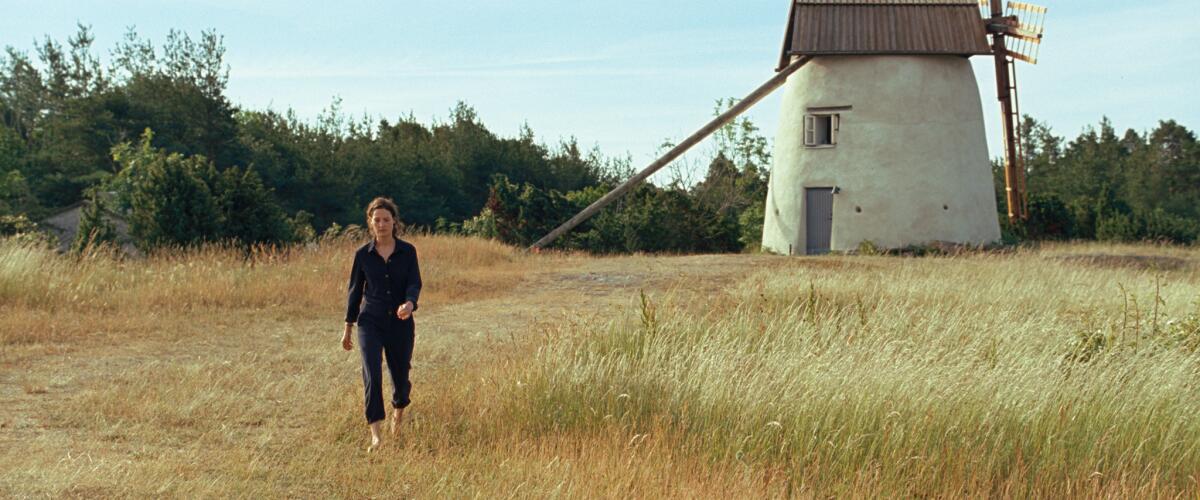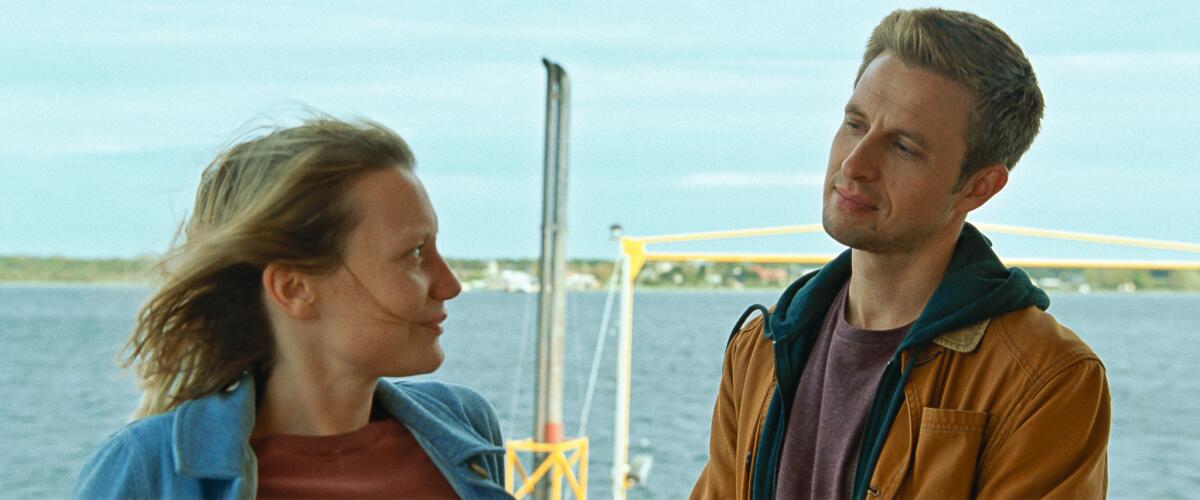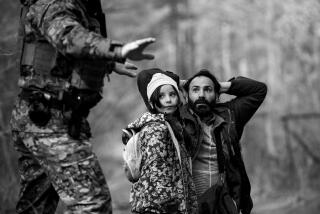Review: Mia Hansen-Løve’s captivating ‘Bergman Island’ lures us into a maze of meta-mirrors

The Times is committed to reviewing theatrical film releases during the COVID-19 pandemic. Because moviegoing carries risks during this time, we remind readers to follow health and safety guidelines as outlined by the Centers for Disease Control and Prevention and local health officials.
If you’ve watched Ingmar Bergman’s 1973 miniseries, “Scenes From a Marriage” — as you may have done recently, perhaps in preparation for the new HBO remake — you know there’s a particular pleasure to be found in each episode’s closing moments.
“And while you look at this footage of Fårö, here are the credits,” a voice soothingly intones over images of that remote island where Bergman lived, died and shot some of his most celebrated films, this one included. After watching Liv Ullmann and Erland Josephson rip into each other for an hour, it’s lovely to gaze upon a hazy sunset or a lonely lighthouse and experience a moment’s reprieve. Not that the Fårö we see in Bergman’s movies is an especially tranquil place. On the contrary, the works it inspired — including “Through a Glass Darkly,” “Persona” and “Shame” — are among his most shattering and uncompromising, forging an intense connection between his characters’ ravaged emotional landscapes and the craggy Baltic Sea shores they call home.
Fourteen years after the Swedish master’s death, Fårö’s beauty engulfs the screen once more in “Bergman Island,” Mia Hansen-Løve’s charmingly mischievous and quietly entrancing new movie. It follows married filmmakers Chris (Vicky Krieps) and Tony (Tim Roth), who have traveled from the U.S. to Fårö for a summer writers’ residency program, hoping to absorb some of the creative fertility that Bergman reliably found in its sun-dappled soil. In this haven for cinephiles and sheep enthusiasts, Chris and Tony scribble in their notebooks, stay in the house from “Scenes From a Marriage” (“the film that made millions of people divorce!” their welcomer gushes) and mingle with the Bergman scholars who make up much of the local and visiting population.

It would be amusing to report that Chris and Tony stumble on a patch of wild strawberries or play an epic game of seaside chess. But while there are a few jokey allusions scattered through “Bergman Island,” Hansen-Løve shows little interest in burdening her wisp of a story with an extended Bergman homage. Fårö already is an extended Bergman homage, an auteurist amusement park, if amusement park is what you call a place with screenings of “Cries and Whispers.” With whispers of satire and quasi-anthropological fascination, Hansen-Løve surveys the rituals of this curious pilgrimage, watching as visitors check out the Bergman Center museum and swap Bergman trivia on the “Bergman Safari” tour bus.
What Hansen-Løve herself thinks of Bergman is one of a few mysteries percolating beneath her movie’s invitingly calm surface. She’s spoken in interviews of her “passionate relationship” with his life and art, and her decision to set an entire feature on his home turf (beautifully photographed by Denis Lenoir) certainly speaks to that passion. But the movie’s attitude toward Bergman is beguilingly open-ended, aligning itself with neither the worshipful tributes nor the dismissive reappraisals that greeted his decades-long career. Even Hansen-Løve’s characteristically light, unassuming touch feels like a playful rejoinder to the weight of the Bergman mystique, a refusal to let him dictate the terms of the argument.
Early on, Chris takes a jab at the patriarchal entitlement that allowed Bergman to enjoy such artistic longevity, to the detriment of the nine children he fathered but had little hand in rearing. It would be a mistake to assume that Chris speaks for her maker; it would also be a mistake to assume that she doesn’t, especially when she critiques an industry in which women artists are regularly underrepresented and/or sidelined for family reasons and in which her own husband has enjoyed a more decorated, established career. And when Chris and Tony gently bicker, swap work notes and mention their young daughter back at home, the informed art-house patron may be hard-pressed not to think of Hansen-Løve and Olivier Assayas, two acclaimed French filmmakers and former partners with a child of their own.
And why shouldn’t we think of them? Bergman, who romanced his leading ladies and strip mined his personal demons for material, was hardly the least self-involved of European auteurs, and Hansen-Løve has fittingly responded with her own teasing display of meta-effrontery. “Bergman Island” is her first movie in the English language but not her first to draw details from her family life (“Goodbye First Love,” “Eden”) or consider the daunting pressures of the film business (“Father of My Children”). But it’s surely her most emotionally and intellectually playful, her least susceptible to easy classification.

That there is trouble in Chris and Tony’s paradise feels obvious, even if the sources of that trouble are not. The possibility of infidelity hangs in the air — hinted at in the pages of Tony’s notebook and by the long afternoon Chris spends with a Swedish film student (Hampus Nordenson) — without ever becoming a tangible threat. Krieps, who came to prominence (in “Phantom Thread”) playing another wife struggling to assert herself emotionally and professionally, gives similarly luminous shape to Chris’ anxiety and artistic blockage. She and Roth convey marital tensions so subtle they almost evaporate between scenes; they never raise their voices, and neither does Hansen-Løve. Melodrama, a form that Bergman transfigured so brilliantly, feels alien to her temperament.
The only way out of this labyrinth of meta-mirrors, apparently, is to plunge deeper into it. And so Chris, working through her creative and romantic frustrations, begins telling Tony about the latest movie she’s writing, a movie that takes shape before our eyes. It’s about a 28-year-old filmmaker, Amy (Mia Wasikowska), and her on-and-off romance with Joseph (Anders Danielsen Lie), which arrives at a possible turning point when they travel to Fårö for a friend’s destination wedding. For long, uninterrupted stretches we are with Amy and Joseph as they circle each other, make love and mull the possibilities and impossibilities of the future. There’s a smattering of ABBA (Sweden’s other great cultural export) and, naturally, a little Bergman talk, though the more salient auteurs hovering over this film-within-a-film might be Eric Rohmer and Richard Linklater.
Amy and Joseph’s story is so gently enveloping that it may take you a while to start parsing the intricate parallels that bind Amy and Chris to Hansen-Løve, or to tease out where this story is headed and what it might mean for a relationship on the verge of either disintegration or salvation. Hansen-Løve seems to be discovering the answers herself as she goes along, which explains why she leaves so much unsaid, often relying on fleeting images — a solo bike ride, a white dress, a child’s smile — to express feelings too bittersweet and evanescent for words. What she leaves us with is a powerfully concrete impression of Fårö itself, as well as a desire to discover, or rediscover, the images that immortalized it. Hansen-Løve may not see in it exactly what Bergman saw, but she is no less in thrall to its strange, melancholy magic.
‘Bergman Island’
Rated: R, for some sexual content, nudity and language
Running time: 1 hour, 52 minutes
Playing: Starts Oct. 15 at Laemmle Playhouse 7, Pasadena; Laemmle Glendale; the Landmark, West Los Angeles; Laemmle Town Center 5, Encino; the Frida Cinema, Santa Ana; Regency Theatre, Westlake Village; and Regency Theatres Directors Cut Cinema, Laguna Niguel
More to Read
Only good movies
Get the Indie Focus newsletter, Mark Olsen's weekly guide to the world of cinema.
You may occasionally receive promotional content from the Los Angeles Times.











